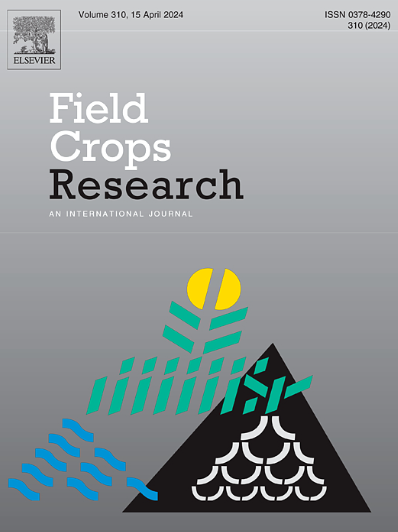Relationship between agricultural water and soil resources carrying capacity and crop yield with long-term plastic film mulching coupled with fertilization
IF 5.6
1区 农林科学
Q1 AGRONOMY
引用次数: 0
Abstract
Context
The black soil area located in northeast China is one of the four major black soil areas in the world, with developed agriculture. Due to the long-term intensive utilization of cultivated land and low nutrient input, the deterioration of soil and water resources in cultivated land is accelerated, which challenges the carrying capacity of cultivated land and water resources for grain production. However, the impact of the carrying capacity of land and water resources on grain production at field scale is still unclear. This is crucial for optimizing tillage measures to promote the steady improvement of the carrying capacity of cultivated land and water resources for food production.
Objective
Utilizing a 37-year long-term field positioning experiment, this study quantitatively evaluated the agricultural water and soil resources carrying capacity index (WSI) under varying mulching and fertilization regimes and established their functional correlations with maize yield dynamics.
Methods
Based on the 37 year continuous mulching and fertilization experiment of brown earth at Shenyang Agricultural University, 14 treatments were selected, including single application of nitrogen fertilizer (N2, N4), single application of organic fertilizer (M2, M4), organic fertilizer+nitrogen fertilizer (M1N1, M2N2), and no fertilization (CK), under mulching (F) and non mulching (WF) conditions.
Results
The results showed that both mulching and fertilization can significantly improve the WSI and crop yield. Among them, the treatment of mulching with high organic fertilizer and nitrogen fertilizer (FM2N2) had the most significant effect on both carrying capacity and yield of agricultural water and soil resources. For every 0.1 unit increase in the WSI, the yield of corn under mulching and non mulching conditions can increase by 11.8 % and 12.01 %, respectively. Under mulching conditions, the average yields of N2, N4, M2, M4, M1N1, and M2N2 treatments increased by 43.91 %, 71.3 %, 62.84 %, 97.38 %, 68.58 %, and 85.3 %, respectively. The WSI increased by 6.61 %, 7.47 %, 16.97 %, 20.29 %, 18.83 %, and 22.6 %, respectively; Under non mulching conditions, the average yields of N2, N4, M2, M4, M1N1, and M2N2 treatments increased by 48.1 %, 65.5 %, 97.79 %, 134.72 %, 120.55 %, and 122.32 %, respectively. The WSI increased by 4.07 %, 5.58 %, 13.63 %, 18.29 %, 16.78 %, and 20.31 %, respectively. Overall, except for the CK treatment, the WSI of the mulching fertilization treatment was higher than that of the non mulching fertilization treatment.
Conclusions
Under long-term high-intensity intensive management conditions, film mulching, single application of organic fertilizer (FM4), and combination application of film mulching organic fertilizer and nitrogen fertilizer (FM2N2) are effective ways to achieve dual improvement of agricultural water and soil resource carrying capacity and crop yield.
Implications
The research results can provide theoretical guidance and technical path implementation references for the dual improvement of agricultural water and soil resource carrying capacity and grain yield in Northeast China cultivated land.
长期地膜覆盖配施肥对农业水土资源承载力与作物产量的影响
位于中国东北的黑土区是世界四大黑土区之一,农业发达。由于长期的耕地集约利用和低养分投入,加速了耕地水土资源的恶化,对粮食生产的耕地和水资源承载能力提出了挑战。然而,在大田尺度上,水土资源承载能力对粮食生产的影响尚不清楚。这对于优化耕作措施,促进耕地和水资源对粮食生产的承载能力稳步提高至关重要。目的利用37年的长期田间定位试验,定量评价不同覆盖和施肥制度下的农业水土资源承载能力指数(WSI),并建立其与玉米产量动态的功能相关性。方法在沈阳农业大学棕土37年连续覆盖与施肥试验的基础上,选取单施氮肥(N2、N4)、单施有机肥(M2、M4)、有机肥+氮肥(M1N1、M2N2)、不施肥(CK)、覆盖(F)和不覆盖(WF)条件下的14个处理。结果覆盖和施肥均能显著提高水稻WSI和作物产量。其中,高有机肥加氮肥(FM2N2)覆盖处理对农业水土资源承载能力和产量的影响最为显著。WSI每提高0.1个单位,覆盖和不覆盖条件下玉米产量分别提高11.8 %和12.01 %。覆盖条件下,N2、N4、M2、M4、M1N1和M2N2处理的平均产量分别提高43.91 %、71.3 %、62.84 %、97.38 %、68.58 %和85.3 %。WSI分别增加了6.61 %、7.47 %、16.97 %、20.29 %、18.83 %和22.6 %;在不覆盖条件下,N2、N4、M2、M4、M1N1和M2N2处理的平均产量分别提高48.1 %、65.5 %、97.79 %、134.72 %、120.55 %和122.32 %。WSI分别上升了4.07 %、5.58 %、13.63 %、18.29 %、16.78 %、20.31 %。总体而言,除CK处理外,覆盖施肥处理的WSI高于不覆盖施肥处理。结论在长期高强度集约经营条件下,膜覆盖、单施有机肥(FM4)和膜覆盖有机肥与氮肥(FM2N2)配施是实现农业水土资源承载能力和作物产量双重提高的有效途径。研究结果可为东北耕地农业水土资源承载力与粮食产量的双重提升提供理论指导和技术路径实施参考。
本文章由计算机程序翻译,如有差异,请以英文原文为准。
求助全文
约1分钟内获得全文
求助全文
来源期刊

Field Crops Research
农林科学-农艺学
CiteScore
9.60
自引率
12.10%
发文量
307
审稿时长
46 days
期刊介绍:
Field Crops Research is an international journal publishing scientific articles on:
√ experimental and modelling research at field, farm and landscape levels
on temperate and tropical crops and cropping systems,
with a focus on crop ecology and physiology, agronomy, and plant genetics and breeding.
 求助内容:
求助内容: 应助结果提醒方式:
应助结果提醒方式:


